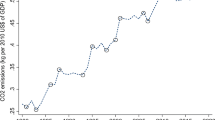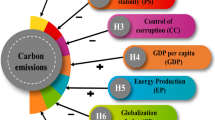Abstract
The study differs substantially from earlier studies, by probing the environmental consequences of foreign aid and selected key economic indicators with a special focus on Sino-Africa. The study focused on China and its top foreign aid recipients in Africa in the last decade. This paper utilizes the Dynamic Augmented Mean Group Estimator (AMG), a robust and recent econometric approach to provide better statistical inferences; crucial for policy formulation and future reforms on foreign aid, trade, energy, pollutions, and economic growth of economies. The findings of the study revealed the China’s Foreign aid oriented towards infrastructure has varying impacts on the economic growth and the environment of most recipient African Countries. The findings revealed the incidence of foreign aid ameliorating pollution of the countries: Nigeria and Morocco under strong domestic institutions. The study is of key relevance for policymakers and stakeholders as it explicates the key pillars, policies, and guidelines needed for foreign aid, trade, economic growth, and related internal reforms for mitigating resulting environmental pollution across a wider international context.

Similar content being viewed by others
Data availability
Data on study variables can be extracted from the following sources: http://china.aiddata.org; https://comtrade.un.org/data; and https://databank.worldbank.org/source/world-development-indicators
References
Adams J, Elassal O (2020) Can foreign aid contribute to sustained growth? A comparison of selected African and Asian countries. World Journal of Entrepreneurship, Management and Sustainable Development
Adams S, Klobodu EKM (2018) Capital flows and economic growth revisited: Evidence from five Sub-Saharan African countries. Int Rev Appl Econ 32(5):620–640
AidData (2018) Available: http://china.aiddata.org/ Accessed 20 Oct 2020
Alharthi M, Dogan E, Taskin D (2021) Analysis of CO 2 emissions and energy consumption by sources in MENA countries: evidence from quantile regressions. Environmental Science and Pollution Research, 28, 38901–38908.
Amusa K, Monkam N, Viegi N (2016) The political and economic dynamics of foreign aid: A case study of United States and Chinese aid to sub-Sahara Africa. ERSA-Economic Research Southern Africa 21(5):363–373
Ang JB (2010) Does foreign aid promote growth? Exploring the role of financial liberalization. Rev Dev Econ 14(2):197–212
Arvin BM, Dabir-Alai P, Lew B (2006) Does foreign aid affect the environment in developing economies? J Econ Dev 31(1):63
Askarov Z, Doucouliagos H (2015) Development aid and growth in transition countries. World Dev 66:383–399
Ansari M, Ehrampoush MH, Farzadkia M, Ahmadi E (2019) Dynamic assessment of economic and environmental performance index and generation, composition, environmental and human health risks of hospital solid waste in developing countries; A state of the art of review. Environ Int 132:105073
Balcilar M, Tokar B, Godwin O-W (2020) Examining the interactive growth effect of development aid and institutional quality in Sub-Saharan Africa. Journal of Development Effectiveness 12(4):361–376
Bjørnskov C. (2019) Types of foreign aid. In Lessons on Foreign Aid and Economic Development, pp 33–61.Palgrave Macmillan, Cham.
Boamah KB, Du J, Bediako IA, Boamah AJ, Abdul-Rasheed AA, Owusu SM (2017) Carbon dioxide emission and economic growth of China—the role of international trade. Environ Sci Pollut Res 24(14):13049–13067
Dauda L, Long X, Mensah CN, Salman M (2019) The effects of economic growth and innovation on CO 2 emissions in different regions. Environ Sci Pollut Res 26(15):15028–15038
Destek MA, Sarkodie SA (2019) Investigation of environmental Kuznets curve for ecological footprint: the role of energy and financial development. Sci Total Environ 650:2483–2489
Eberhardt M (2012) Estimating panel time-series models with heterogeneous slopes. The Stata Journal 12(1):61-71
Guaadaoui, A., ElYadini, M., Chiat, K., Jdaini, T., & El Hajjaji, S. (2021). Preserving the Environment and Establishing Sustainable Development: An Overview on the Moroccan Model. In E3S Web of Conferences (Vol. 234, p. 00065). EDP Sciences
Horowitz AW, Kali R, Song H (2021) Rethinking the aid–growth relationship: A network approach. Review of Development Economics 25(1):359–380
Hongxing Y, Abban OJ, DankyiBoadi A (2021) Foreign aid and economic growth: Do energy consumption, trade openness and CO2 emissions matter? A DSUR heterogeneous evidence from Africa’s trading blocs. Plos one 16(6):e0253457
Huang S, An H, Viglia S, Buonocore E, Fang W, Ulgiati S (2017) Revisiting China-Africa trade from an environmental perspective. J Clean Prod 167:553–570
LaPlue LD (2019) The environmental effects of trade within and across sectors. J Environ Econ Manag 94:118–139
Liu A, Tang B (2018) US and China aid to Africa: Impact on the donor-recipient trade relations. China Econ Rev 48:46–65
Lovely M, Popp D (2011) Trade, technology, and the environment: Does access to technology promote environmental regulation? J Environ Econ Manag 61(1):16–35
Mahalik MK, Villanthenkodath MA, Mallick H, Gupta M (2021) Assessing the effectiveness of total foreign aid and foreign energy aid inflows on environmental quality in India. Energy Policy 149:112015
Malley C S, Omotosho D, Bappa B, Jibril A, Tarfa P, Roman M, ... Lefèvre EN (2021) Integration of climate change mitigation and sustainable development planning: Lessons from a national planning process in Nigeria. Environmental Science & Policy 125: 66-75
Mensah CN, Long X, Boamah KB, Bediako IA, Dauda L, Salman M (2018) The effect of innovation on CO 2 emissions of OCED countries from 1990 to 2014. Environmental Science and Pollution Research, 25(29), 29678–29698
Mustafa, M. E., Elshakh, M. M., & Ebaidalla, E. M. (2019). Does Foreign Aid Promote Economic Growth in Sudan? Evidence from ARDL Bounds Testing Analysis. Journal of Economic Cooperation & Development, 40(3), 115-140
Opoku-Mensah, P. (2009). China and the international aid system: challenges and opportunities. Research Center on Development and International Relations. Aalborg University, Aalborg, p 16
Pesaran MH (2015) Testing weak cross-sectional dependence in large panels. Econometric reviews 34(6-10):1089–1117
Pesaran MH, Yamagata T (2008) Testing slope homogeneity in large panels. Journal of Econometrics 142(1):50–93
Pettersson J, Johansson L (2013) Aid, aid for trade, and bilateral trade: an empirical study. J Int Trade Econ Dev 22(6):866–894
Phillips PC, Sul D (2003) Dynamic panel estimation and homogeneity testing under cross section dependence. Economet J 6(1):217–259
Rao, D. T., Sethi, N., Dash, D. P., & Bhujabal, P. (2020). Foreign aid, FDI and economic growth in South-East Asia and South Asia. Global Business Review, 1-17.
Tahir M, Estrada MAR, Afridi MA (2019) Foreign inflows and economic growth: An emiprical study of the SAARC region. Econ Syst 43(3–4):100702
United Nations Comtrade Statistics Database. https://comtrade.un.org/data/. Last accessed: 24.10.2020
Winters MS, Martinez G (2015) The role ofgovernance in determining foreign aid flow composition. World Development 66:516–531
World Bank (2018), World Bank Indicators. Washington, DC. http://data.worldbank.org/indicator. Last accessed on 21.08.2020
Zhenjian M, Boamah KB, Long X (2020) Research on entropy generation strategy and its application in carbon trading market. Bus Strateg Environ 29(5):1992–2000
Zou B, Li S, Lin Y, Wang B, Cao S, Zhao X, Duan X (2020) Efforts in reducing air pollution exposure risk in China: State versus individuals. Environ Int 137:105504
Funding
This work was supported by Special Funds of the National Social Science Funds of China (18VSJ038).
Author information
Authors and Affiliations
Contributions
Conceptualization [Kofi Baah Boamah and Jianguo Du]; Curation and formal analysis [Kofi Baah Boamah, Jianguo Du, Isaac Adjei Mensah]; Funding and Supervision by [Jianguo Du]; Investigation and Methodology [Kofi Baah Boamah, Jianguo Du, and Isaac Adjei Mensah] Writing-review and editing [Kofi Baah Boamah, Jianguo Du, Isaac Adjei Mensah ,Samuel Antwi , Abdul-Samad Siddique and James Ntiamoah Doku]. All authors read and approved the final manuscript.
Corresponding author
Ethics declarations
Ethics approval
Not applicable.
Consent to participate
Not applicable.
Consent for publication
All the authors have agreed for the manuscript to be published and grants the publisher of this manuscript the exclusive license of the full copyright.
Conflicts of interest
The authors declare that they have no conflicts of interest.
Additional information
Responsible editor: Nicholas Apergis.
Publisher's note
Springer Nature remains neutral with regard to jurisdictional claims in published maps and institutional affiliations.
Rights and permissions
About this article
Cite this article
Boamah, K.B., Du, J., Mensah, I.A. et al. The environmental consequences of foreign aid and key economic indicators: the Sino-Africa perspective. Environ Sci Pollut Res 29, 56281–56290 (2022). https://doi.org/10.1007/s11356-021-16880-1
Received:
Accepted:
Published:
Issue Date:
DOI: https://doi.org/10.1007/s11356-021-16880-1




